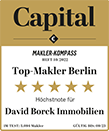Real Estate Reinikendorf
When an airplane takes off or lands, it gets loud in some parts of Reinickendorf. Many planes fly so low that it seems people could almost touch them. These times should actually have been long past and the new major airport in Schönefeld should be operational. But for as long as the mishaps continue to pile up there, Tegel airport needs to remain open. But postponed is not abandoned. And in the mean time, the locals simply get out of the way: because quiet corners are abundant in the ten quarters of the district.
Particularly in Heiligensee, Hermsdorf, Wittenau, Lübars and Frohnau, life is almost like in the country, apart from the excellent connections to the city, of course. Especially Lübars up north has retained a rural character. There are manors, a historic village centre and even a volunteer fire brigade. Frohnau on the other hand is dominated by stately art nouveau villas and alleys: designed in 1910 as a garden town following the English model, the town with an S-Bahn connection is very green and completely surrounded by forest. The tranquillity has also brought forward a special building: the Buddhist House, Europe’s oldest Buddhist centre.
In Hermsdorf, Heiligensee, Konradshöhe and Tegel, the waterfront and forest locations on the banks of the Havel, around the Waldsee, on Tegeler See, on Tegeler Fließ and at the Tegeler Forst are among the most popular. Day trippers also appreciate the forest and water-rich environment, go for walks on the numerous hiking trails, cool themselves down in the public bathing beaches of Heiligensee and Lübars or take a steamboat trip on the Tegeler See.
In Reinickendorf itself, it can already be felt more clearly that you are not in the country, but in the German capital. Even though the village green of Alt-Reinickendorf with its church has been preserved, and there are still some old farm houses, the town is more densely populated in general. Stucco decorated Gründerzeit buildings alternate with new buildings. And the town also accommodates a Unesco World Cultural Heritage: the “Weiße Stadt” on Arosa Allee, a large housing complex of Berlin’s modern era, developed in the style of New Objectivity between 1929 and 1931.
Tegel too has a rather urban character, but with its lake and the nearby forest it also offers easy escape. The district is also home to three special contemporary witnesses: the Borsig Tower, a brick-built high rise from the year 1922, the Alte Waldschänke with its history of 250 years and “Dicke Marie”, a 900 year old English oak. Tegel therefore has the oldest high-rise building, the oldest restaurant and the oldest tree of the city. There can hardly be any more history!
The Märkische Viertel, which is also part of the district, is historically no less important. The high rise complex owes its development to the post-war housing shortage. Between 1964 and 1974, 17,000 apartments for 50,000 people were developed in the first large new construction complex of West-Berlin. Too fast to provide for the necessary infrastructures. There was a lack of schools, kindergartens, playgrounds, green space, stores, cafés and restaurants. And the travel connections were poor. People were frustrated and the reputation of the quarter suffered. But the high-rises have been renovated, streets, squares and parks re-designed and recreational opportunities created. Today, people can live here in grown structures, close to the centre and affordable.

 Back
Back 







